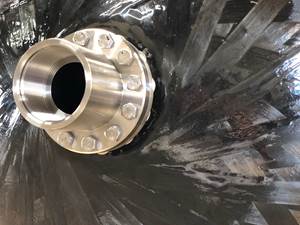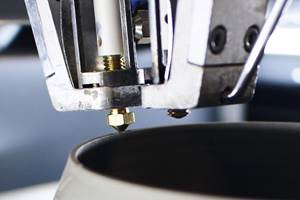Agile Ultrasonics breaks new ground for ultrasonic composites welding in space manufacturing
Continuous ultrasonic welding (CUW) innovation presents the flexibility crucial for future lunar and deep-space missions, but also for composites joining in defense and commercial aerospace.
Chris Skocik, Agile Ultrasonics engineering manager, is loading the company’s vacuum chamber in preparation for an ultrasonic weld trial joining CFRTP at the company’s facility in Columbus, Ohio. Source | Agile Ultrasonics
Agile Ultrasonics (Columbus, Ohio, U.S.), a company developing advanced ultrasonic welding solutions for thermoplastic composites (TPC), and a key player in the “Structural Materials Joining in Space” project, funded by Ohio Federal Research Network (OFRN), is tackling the challenge of achieving reliable TPC welding in the harsh, environmental conditions of space. This project is an enabler for in-space manufacturing, servicing and repair —technologies that NASA and other industry leaders could use for the future of deep-space exploration.
Agile Ultrasonics’ expertise extends beyond space applications, with a strong foundation in developing, designing and manufacturing advanced robotic end effectors for critical polymer composites joining. As Jim Stratton, president of Agile Ultrasonics highlights, the company’s technology has been installed in top-tier aerospace and is being evaluated for use in U.S. Air Force, and NASA programs. Agile’s innovations include continuous ultrasonic welding (CUW) without the need for energy directors, film layers or other inserts — an advancement that enhances efficiency and reliability while expanding material selection options for component designers. Additionally, the company’s solutions enable precise shaping and compacting of high-performance carbon fiber-reinforced thermoplastic (CFRTP) composites, supporting both terrestrial- and space-based applications.
Overcoming the challenges of space welding
Traditional ultrasonic welding techniques often require additional materials, such as energy directors or resin inserts, which introduce complexities in space where weight and automation are critical concerns. To address this challenge, and through the aforementioned OFRN project, Agile Ultrasonics has developed CUW without the need for energy directors or film layer inserts, a process that can be used to eliminate auxiliary materials while ensuring high-performance joints in TPCs such as LM-PAEK, PEEK or PEKK prepregs, which are widely used in aerospace structures.
“The ‘Structural Materials Joining in Space’ project that Agile has been awarded by Parallax Research seeks to develop baseline ultrasonic welds of TPCs in extreme space conditions. No data is currently known to exist for this type of ultrasonic welding,” Stratton explains.
To test its technology, Agile has designed and built a custom vacuum chamber capable of simulating the extreme thermal fluctuations of space, ranging from -190°C to +120°C. This chamber enables real-time, in-weld temperature monitoring using a sensor array that provides critical data to correlate thermal profiles with mechanical strength. According to Stratton, these insights are essential for refining welding parameters and ensuring the long-term reliability of TPC welds in space environments.
Notably, the CUW technology represents an opportunity for space-based and terrestrial composites manufacturing. Unlike conventional ultrasonic welding systems, Agile has commercialized its technology as a modular, adaptable robot-agnostic end effector. This flexibility could be crucial for future lunar and deep-space missions, where robotic assembly and repair may be necessary for constructing and maintaining spacecraft structures and habitats.
“Agile created the option of applying this highly adaptable, modular, low-power, machine-driven robotic system to structural element manipulation, joining and repurposing of composite materials on-orbit or on the lunar surface,” Stratton elaborates. “By correlating weld test data with corresponding weld temperature data, we will advance understanding of the environmental impact on welds as they occur.”
Beyond space applications, Agile’s CUW technology has potential for defense and commercial aerospace where the ability to create high-strength, lightweight composite joints — without adhesives or reinforcements — can be significant for advanced aerospace structures. Current efforts include maturing the technology to support advanced air mobility (AAM) systems and potentially autonomous collaborative platforms (ACP) for AFRL through Midwestern Regional Network funding.
Industry collaboration and commercialization
Agile Ultrasonics’ success is built on strategic supply chain partnerships including material and robotic systems makers, Tier 1 aerospace, NASA, the U.S. Air Force and research institutions including the University of Dayton Research Institute (UDRI), The Ohio State University, Central State University and Oak Ridge National Laboratory (ORNL). These collaborations have been critical in bridging the gap between research and real-world applications.
Support from the OFRN Round 6 program has accelerated Agile’s commercialization efforts, enabling the company to demonstrate its advancements in ultrasonic welding technology to key aerospace stakeholders. The funding has also enabled crucial testing, process refinement and validation studies that strengthen Agile’s composites joining leadership.
“OFRN 6 has provided leverage for Agile to grow its existing business with NASA and helped Parallax demonstrate to its funding source that the support Agile has received through OFRN 6 is producing jobs, breakthrough technology and follow-on programs as proposed at the outset,” Stratton notes. “Further, the work being done under OFRN 6 has helped Agile gain traction with the U.S. Air Force. Agile recently received an award from the Air Force Research Lab [AFRL] Midwest Regional Network to apply its continuous ultrasonic welding of thermoplastic composites to an AFRL-funded program.”
Agile Ultrasonics continues to refine its CUW process. Stratton believes that it will not only play a vital role in the long-term vision of sustainable space exploration, but also unlock new opportunities for high-performance composites in aviation, AAM and defense through continued collaboration and industry support.
“We have worked almost daily with our stakeholders at NASA’s Glenn Research Center in Cleveland, NASA’s Langley Research Center in Hampton, Virginia, and NASA’s Goddard Space Flight Center in Greenbelt, Maryland. We have hosted multiple face-to-face visits at our facility and collaborated extensively on ultrasonic welding projects within and outside of OFRN 6,” Stratton emphasizes. “Our objective is to advance Agile’s technology so that it becomes an integral part of the supply chain as a go-to platform for joining, shaping, compacting, sealing or consolidating TPCs. An immense effort will be required to achieve this level of commercial success.”
Air Force Research Lab AFRL-2025-2496. Distribution statement A: Approved for Public Release: distribution is unlimited.
Related Content
Infinite Composites: Type V tanks for space, hydrogen, automotive and more
After a decade of proving its linerless, weight-saving composite tanks with NASA and more than 30 aerospace companies, this CryoSphere pioneer is scaling for growth in commercial space and sustainable transportation on Earth.
Read MoreManufacturing the MFFD thermoplastic composite fuselage
Demonstrator’s upper, lower shells and assembly prove materials and new processes for lighter, cheaper and more sustainable high-rate future aircraft.
Read MoreNext-generation airship design enabled by modern composites
LTA Research’s proof-of-concept Pathfinder 1 modernizes a fully rigid airship design with a largely carbon fiber composite frame. R&D has already begun on higher volume, more automated manufacturing for the future.
Read MoreA new era for ceramic matrix composites
CMC is expanding, with new fiber production in Europe, faster processes and higher temperature materials enabling applications for industry, hypersonics and New Space.
Read MoreRead Next
TAVieDA project team cuts aircraft door production time using thermoplastic composites, welding
Fraunhofer groups, Trelleborg and Airbus develop modular, fully automated assembly system concept to replace metals and time-consuming assembly that shows potential for scalability.
Read MoreMM-Welding solution automates, functionalizes composite joining
Ultrasonic joining has been used for decades, but is now being advanced to enable smart, automated fastening in composites and multi-material assemblies.
Read MoreAssembling the Multifunctional Fuselage Demonstrator: The final welds
Building the all-thermoplastic composite fuselage demonstrator comes to an end with continuous ultrasonic welding of the RH longitudinal fuselage joint and resistance welding for coupling of the fuselage frames across the upper and lower halves.
Read More



























